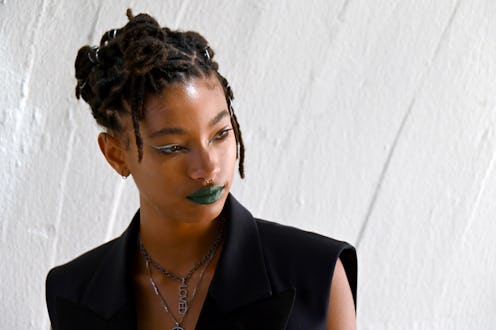(Beauty)
How To Recreate The Eyeliner Trend That’s Taking Over Pinterest, According To Makeup Artists

Between the endless content Instagram and Twitter (and maybe even TikTok) provide, every now and again, you may forget to check in on another inspo-churning site: Pinterest. But with the many shelter-in-place and social-distancing practices happening in light of the coronavirus, people are turning to the site now more than ever — literally. According to stats shared with The Zoe Report, Pinterest saw the highest number of searches and saves over the weekend of March 21 than *any* other weekend prior. And amongst the most popular beauty-related searches? Inner corner eyeliner tutorials.
Searches for the look that extends the eye shape by lining past the inner lash line and toward the nose were up 293 percent on Pinterest from March 9 to 22 (as compared to the two weeks prior). And just by scrolling through photos, it's easy to see why: It's ultra sleek and exudes an edgier vibe than a traditional winged liner. But much like its trendy cousin, floating eyeliner, the look seems a tad difficult to recreate. Hence why so many people were probably searching for a step-by-step tutorial in the first place.
While YouTube videos are basically online crash-courses, to spare you the time of searching and watching, The Zoe Report got in touch with two professional makeup artists to break down how anyone — beginner to expert — can create the look: L’Oréal Paris celebrity (hi, Beyoncé) makeup artist Sir John, and Global Makeup Artist for Urban Decay Cosmetics, Steve Kassajikian.
First things first: the base. "For this look, it’s important to conceal the dark circles [around your eyes] so the color pops and it doesn’t look muddied," explains Sir John in an email. It doesn't take much; simply apply concealer, set with a touch of powder, and you're onto eyeliner. Kassajikian recommends lining the top lash line to start, then bringing the line past the inner corner of the eye. You can go in one fell swoop, or as Sir John suggests, work in tight, short lines to maintain control.
Once finished with the entire top line, draw a small line on the inner corner of the bottom lash line to connect the two. Clean up any stray marks with a cotton bud and voilà — you're done. As for what type of liner to use, Kassajikian and Sir John both suggest smudge-proof pencils like L'Oréal Paris' Infallible Pro-Last Waterproof Eyeliner, $8.99, or Urban Decay's 24/7 Glide-On Eye Pencil, $22. But, if liquid or gel is all you have, they'll work just fine.
Ahead, a few different versions of the inner corner eyeliner trend to get your inspiration ball rolling.
Classic Black
"The eye gets more of a demi, feline feel if it’s a brown or black pencil," says Sir John. Channel your inner cat, like FKA Twigs, with a sharp black line and defined wings.
A Bold Color
Draw a little more attention to your look with a bold color like red. Even though it's just a color change, "Something so small can transform or complete any look," says Kassajikian.
Circular Shapes
There's no way to *not* be dramatic with this iteration. Instead of stopping the bottom lash liner part way across, line all the way around the eye connecting your liner both on the inner corner and outer.
Two-Toned
"This look can really be as minimalist or maximalist as you want it to be," says Sir John. Take a page from Willow Smith who falls into the more maximalist side and use two contrasting eyeliners to define the look.
Slightly More Vertical
The inner tail of the look doesn't always have to follow the eye shape. Rather, pull the line straight down parallel to the tear duct for a completely different effect.
If you think you’re showing symptoms of coronavirus, which include fever, shortness of breath, and cough, call your doctor before going to get tested. If you’re anxious about the virus’s spread in your community, visit the CDC for up-to-date information and resources, or seek out mental health support.
This article was originally published on